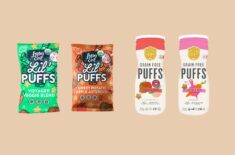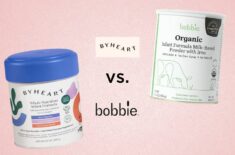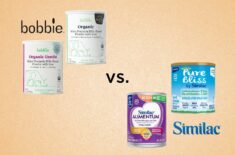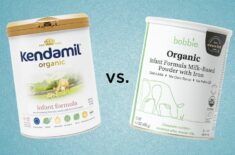Overview
Not sure if your 5-month-old baby is ready for their first bite of solid foods?
We understand that your baby’s introduction to solids is an exciting but also nerve-wracking experience. It gets even more interesting if you plan to skip purees and start with baby-led weaning.
If you’re wondering if it’s safe to introduce solids at five months and want to learn how to do it safely, keep reading because we’re going to break it all down for you, mama.
The introduction of solids is an important milestone as it opens up a new world of opportunity for your baby to explore new tastes and textures. It’s also a great time to practice essential motor skills required for eating.
The timing and the quality of foods you give your baby can affect their life-long health.
Offering food too early can result in a higher risk for obesity or diabetes later in life. Meanwhile, early introduction of allergenic foods can lessen the risk of developing allergies. (1)(2)
What Is BLW?
Baby-led weaning (BLW) is a method where your little one skips traditional purée spoon-feeding and learns to self-feed with appropriately-sized finger foods. BLW fosters independence by giving your baby more control over what and how much they eat.
What Are The Benefits Of BLW?
BLW has been linked to several benefits, including a lower risk of developing obesity or excess weight gain later in life. We discuss some more benefits below and have a more comprehensive discussion about them in our BLW guide. (3)
Do Experts Recommend Baby-Led Weaning?
Experts’ and health professionals’ opinions vary regarding BLW. While there’s support, many agree that there’s no “one size fits all” approach to infant feeding.
Ohio-based pediatrician Kimberly Churbock, MD, recognizes that there are many ways that babies learn to feed themselves.
She explains that the benefits of baby-led weaning aren’t just limited to your baby but the rest of the family as well.
Here are some benefits of BLW: (4)
- Your baby learns social skills because they get to share family meals.
- Since you don’t have to prepare pureed foods, it can save you money and time.
- Your baby learns to have better appetite control than spoon-fed babies.
Dr. Churbock suggests that parents research or discuss their feeding method with their baby’s pediatrician as early as four months of age.
What’s The Recommended Age For Babies to Start Solids?
The AAP (American Academy of Pediatrics) recommends starting solids at six months. However, many pediatricians also give the green light at four months if your baby shows signs of readiness. More on this below. (5)
For an in-depth discussion, we have an article on baby’s first solid foods.
Benefits Of Waiting Until 6 Months To Introduce Solids
- Your baby gets to breastfeed or formula-feed for six months exclusively.
- Breastmilk or formula is an essential source of your baby’s nutrition, especially in their first year of life. (6)
- Lowers their risk for anemia (7)
- Your baby’s digestive system is mature enough for solids. (8)
- Mealtimes can be easier since your baby’s motor skills are more developed.
Can Babies Start Eating At 5 Months?
Experts’ recommendations vary between four to six months. You can check your baby’s signs of readiness by asking the questions we listed below.
Benefits, Dangers, & Drawbacks Of Giving Solid Foods Too Early
If you decide to introduce your baby to solid foods early, there are benefits and drawbacks.
Benefits
Here are some benefits of starting solids before six months old:
- May help promote better sleep ((Experts still debate on this as there are contradicting studies about it.) More on this below.
- The AAP recommends the early introduction of allergens to lower the risk of developing food allergies later in life. (2)
- More willingness to explore new tastes and textures (9)
- Lowers the risk of feeding problems later in life (9)
Dangers & Drawbacks
- It can lead to a higher risk for obesity or diabetes later in life (This claim is still debatable as there are contradicting studies about it.) (1)
- Can lead to overfeeding and your baby being overweight (1)
- Studies show that exclusively breastfed or formula-fed babies for six months have a lower risk of developing anemia. (10)
For more detailed information, we have an article on starting BLW at four months.
Top Signs of Readiness
You can ask the following questions to determine if your baby is ready for solid foods: (11)
Can my baby hold their head in an upright position?
Can my baby sit without support?
Can my baby pick up food and put it in their mouth?
Can my baby swallow food?
Common Signs Usually Mistaken As Readiness
These are normal behaviors and not signs of readiness: (12)
- Frequent nighttime wakings when they’ve already learned to sleep through the night
- Asking for more milk feedings
- Chewing their fists
Premature Babies & Weaning Early
- The recommendation to introduce first foods is around five to seven months of their actual age. (13)
- But since each baby is unique, it may be best to check their signs of readiness. (13)
- Always get the all-clear from your pediatrician before introducing solids.
If you start your premature baby on solids earlier than four months of their actual age or before their three months corrected age, they may face risks or dangers. Some of them are the following: (13)
- Most babies at this age still have a strong tongue-thrust reflex, the act of pushing food out of their mouth.
- Your baby’s gut may not be mature enough to handle solid foods.
- Most babies still haven’t developed the necessary skills to swallow foods properly.
Developmental Milestones At 5-Months-Old
While each baby develops at their own pace, developmental milestones guide us on what to expect as they grow. Here are some of them: (14)
- Improvement in hand-eye coordination and motor skills
- Follows the course of a rolling ball
- Sees different colors
- Looks or focuses on their hands
- Starts to pick up words
- Babbles and coos
- Shows interest in looking at objects
- Responds when you talk
Your 5-Month-Old’s Major Developments
Sleeping
- Sleeps around 8-10 hours at night with three to four naps during the day (15)(16)
- May start experiencing separation anxiety and won’t sleep without a parent nearby. (15)
Feeding
- Consumes six to seven ounces of formula per feeding (17)
- Feeds breastmilk or formula five to six times a day (17)
- If your baby is ready for solids, try giving a teaspoon of food first.
- Introduce new foods one at a time and wait for three to five days to see any allergic reactions.
- It’s best to consult your pediatrician or registered dietitian before introducing allergenic foods such as eggs, especially if you have a history of food allergies.
How Do You Start Baby-Led Weaning At 5 Months?
As soon as your baby is starting with solid foods, they can start baby-led weaning. You don’t need much to start BLW, but there are essential tools to help ensure your baby’s safety:
- Safe-made baby utensils (spoons, bowls, and baby cups)
- Comfortable high chair
- BLW cloth or silicone bibs
- Messy mat or tray
Preparation is the key to ensuring your baby’s safety during BLW. You can reduce the risk of choking by cutting and preparing pieces of food appropriately. More on this below.
Will Starting Solids Early Help Make My 5-Month-Old Baby Sleep Better?
- As a general rule, early introduction of solids doesn’t help your baby sleep better. (12)
- However, a 2018 study showed that babies introduced to solid foods earlier than six months slept significantly better and longer than those who started at the recommended age. (17)
- It also concluded that babies who weaned early experienced lesser sleep problems like irritability or nighttime awakening. (17)
Can I Give Finger Foods To My 5-Month-Old Baby?
If your baby shows signs of readiness for solids, they can already start on finger foods that are cut appropriately. We discuss below how to cut food properly to help prevent it from becoming choking hazards.
Experts say there are no strict food guidelines for most babies. However, it’s best to offer a variety of healthy foods for a balanced diet.
Here are some different foods your can try: (5)
- Iron-rich foods like meat and eggs
- Veggies like spinach, butternut squash, green beans, broccoli florets, and more.
- Healthy fats like nut butter, avocado, and ghee.
- Antioxidant-rich fruits like blueberries and strawberries
As a rule, introduce new foods one at a time and wait for one to three days for any allergic reactions. Seek your baby’s pediatrician or registered dietitian before introducing allergenic foods.
How Often and How Much Should Your 5-Month-Old Baby Eat?
- Offer solid foods in small portions. Begin by giving a teaspoon of food first and slowly increasing to a tablespoon. (18)
- Get your baby comfortable with solid foods first by starting slow with one meal a day. You can gradually increase the frequency as you notice that your baby is ready for more. (18)
- At this age, eating solids is mainly for the sensory experience. Breastmilk or formula is still your baby’s main source of nutrition.
How Do I Know If My 5-Month-Old Baby Is Full?
In BLW, let your baby decide how much food they want. Here are some signs that your baby already had enough food: (19)
- Pushes food away
- Uses hand motions to show they don’t want anymore
- Turns their heads away from food
- Closes their mouth when offered food
- Shows distress or cries when offered food
How To Cut Foods For A 5-Month-Old Baby According To BLW
At this age, your baby’s food should fit perfectly in their hands with a portion sticking out. This allows them to have a firm hold on the food, reducing the risk of choking.
Once your baby develops their pincer grasp, the ability to hold objects between their thumb and forefinger, they can start picking up small pieces of food.
As a general rule, any food can be a choking hazard. To reduce the risk of choking, baby food must be prepared and cut appropriately.
Here are some tips:
- Hard foods like carrots and sweet potatoes must be steamed or cooked until fork tender.
- Cut round-shaped foods like blueberries into small pieces at no bigger than ½ inch.
- Cut foods into small-sized pieces.
- Cylindrical foods like sausage must be cut into strips.
- Remove the pits and skins of fruits and veggies.
Here’s an extensive article on BLW feeding guide per age to know more.
Food Safety For BLW At Five Months
Choking Vs. Gagging
Your baby’s gag reflex prevents them from choking on objects they put in their mouth. This lessens as your baby grows and becomes comfortable eating foods.
If your baby vomits or spits milk or foods after eating, this is called reflux. This is also normal, and your baby will eventually grow out of it like gagging.
Meanwhile, choking is a life-threatening incident where there’s a blockage in your baby’s airway. It’s crucial to know the early signs of choking. Here are some:
- No breathing
- Pale or bluish skin color
- Cannot cry or make sounds
- Weak coughing
- Soft of high-pitched sound while breathing
- Loss of consciousness
For more choking prevention tips, we have an article on BLW & choking.
Feeding Tips
- Widen your baby’s palate by offering a variety of foods.
- Consult your baby’s pediatrician or registered dietitian before introducing common allergenic foods like cow’s milk, peanut butter, eggs, bread, and more.
- Avoid added sugar and preservatives.
- Whenever possible, go for organic non-GMO or options that are minimally processed, refined, or contain additives.
- Choose whole foods like fruits or veggies like avocado around 80% of the time.
Is It Worth It To Wait Until Six Months To Introduce Solids?
Your baby’s cues are important factors in deciding whether or not to wait until six months old to introduce solids. Another factor to consider is your intention. Introducing solid foods early has its benefits as well as drawbacks.
Your baby can benefit from the early introduction of allergenic foods as it reduces their risk for allergies later in life. However, if you’re mainly interested in nutrition, breastmilk or formula is enough until six months of age.
Gill Rapley, the author of “Baby-Led Weaning: The Essential Guide to Introducing Solid Foods-and Helping Your Baby to Grow Up a Happy and Confident Eater,” shares her expert opinion.
According to her, if your baby is developmentally ready, you should go for it. She confirms that the signs of readiness are enough to determine if your baby can eat solids. She added that the digestive markers would just follow.
She explains: (20)
“However, my actual position, based on my research and my clinical experience, is that whatever an individual baby is ready to do is probably what’s right for that baby.
There is good reason to believe that those developmental abilities that are visible to us (sitting upright etc.) are a reliable indicator of the maturity of that baby’s (internal) digestive system – nature very rarely makes mistakes.
So, if a full-term, healthy baby can (genuinely) sit upright, grasp food and get it to his mouth UNAIDED, then he’s probably ready to do just that. If he’s also ready to chew it – and perhaps even swallow it – that’s fine, but it is more likely that these skills will follow in due course.”
REFERENCES
:
- https://www.cdc.gov/mmwr/volumes/69/wr/mm6947a4.htm
- https://publications.aap.org/aapnews/article-abstract/34/2/13/24468/Early-introduction-of-allergenic-foods-may-prevent
- https://www.ncbi.nlm.nih.gov/pmc/articles/PMC5934812/
- https://health.clevelandclinic.org/baby-led-weaning/
- https://www.cdc.gov/nutrition/infantandtoddlernutrition/foods-and-drinks/when-to-introduce-solid-foods.html
- https://kidshealth.org/en/parents/breast-bottle-feeding.html
- https://www.nature.com/articles/srep44726#Sec7
- https://www.fammed.wisc.edu/files/webfm-uploads/documents/outreach/im/handout_baby-led_weaning.pdf
- https://www.frontiersin.org/articles/10.3389/fped.2021.654171/full
- https://www.nature.com/articles/srep44726
- https://www.mayoclinic.org/healthy-lifestyle/infant-and-toddler-health/in-depth/healthy-baby/art-20046200
- https://www.unicef.org.uk/babyfriendly/wp-content/uploads/sites/2/2008/02/Start4Life-Introducing-Solid-Foods-2015.pdf
- https://www.health.qld.gov.au/__data/assets/pdf_file/0024/650805/paed_preterm_solids.pdf
- https://kidshealth.org/en/parents/senses-5mos.html
- https://www.stanfordchildrens.org/en/topic/default?id=infant-sleep-90-P02237
- https://www.wchc.nhs.uk/content/uploads/2019/12/SaferSleep_3-6months.pdf
- https://jamanetwork.com/journals/jamapediatrics/fullarticle/2686726
- https://www.cdc.gov/nutrition/InfantandToddlerNutrition/foods-and-drinks/how-much-and-how-often.html
- https://www.cdc.gov/nutrition/InfantandToddlerNutrition/mealtime/signs-your-child-is-hungry-or-full.html
- http://www.rapleyweaning.com/assets/How_early_is_too_early.pdf












